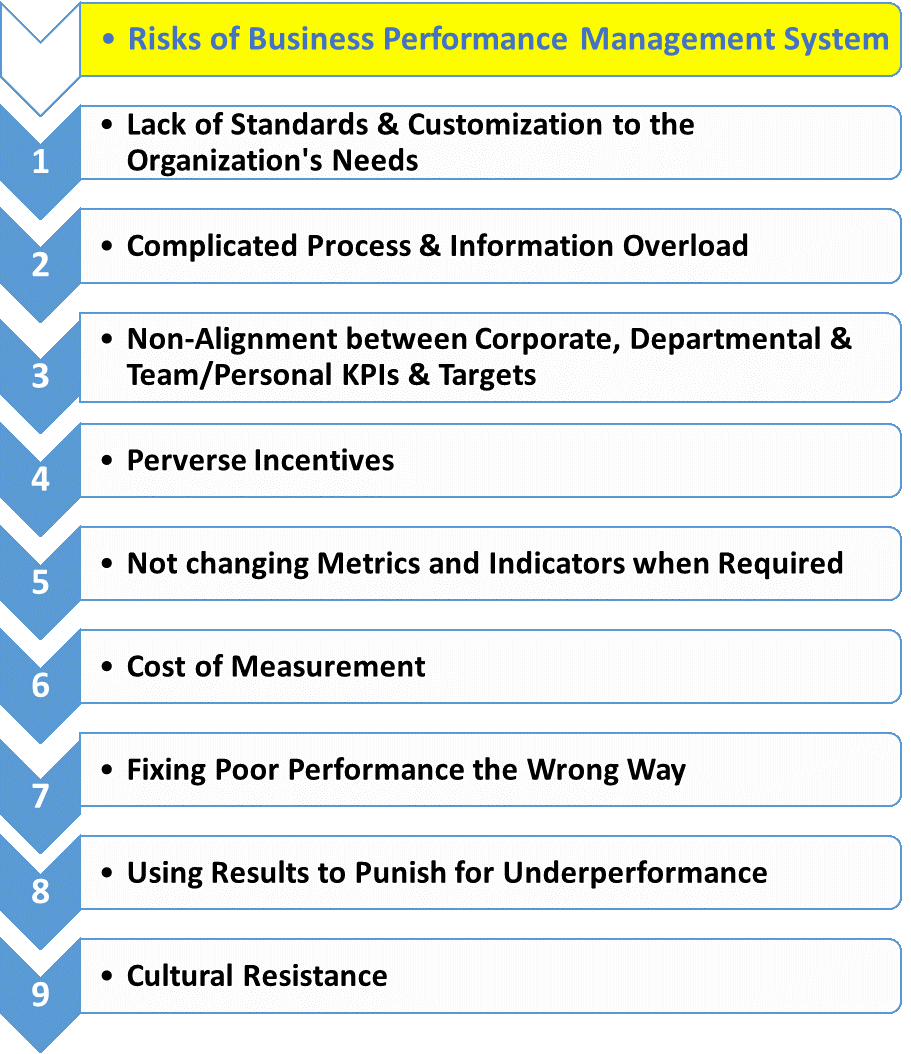The People Performance Management System (PPMS) can improve the output of human capital, increase people satisfaction and have a positive impact on their development.
However, the PPMS has many risks and the Personnel Department (PD) must face them.
 > Many organizations have inefficient PPMS.
> Many organizations have inefficient PPMS.> The PD should strive continuously to develop the process using the feedback, comments, measures and observations received, in close cooperation with Line Management. Often, the PPMS can become extremely complicated and bureaucratic.
> The process must be and always remain focused on providing useful feedback to people in all directions, ideally in a 360 degree way and to the PD.
The PD is responsible for the PPMS process and it must set clear priorities for the process, in parallel with the Executive Management which must do the same for the corporate performance management system using a suitable KPI model such as the Balanced Scorecard one or the EFQM Business Excellence model.
Unless these two system processes are well designed and implemented and unless Line Managers are trained to carry out and do carry out continuously, or at least continually, personal (and team) performance appraisal, no value will be added; on the contrary, value will be destroyed.
> A weak performance management process presents a significant risk.
> Another big risk for performance management is misalignment with corporate culture.
An organization with a Stage Four corporate culture can afford a strict performance management process and an ambitious and demanding goal setting process. The goals can be extremely SMART and challenging and near-impossible, but achievable.
> An organization with a Stage Two or a Stage Three culture should try to implement a softer performance management process.
> The PD should be sensitive in designing the PPMS and deciding about the right timing for introducing the process.
> The fit with the corporate culture is essential as managers can trust the system.
> Tough goals are not suitable for every organization.
> Managers invest a lot of time and energy in conducting effectively a performance management appraisal process and they should be given a broad time frame.
> The risk of a too quick performance management cycle is high.
Once Top Management and the PD design the performance management process and the PPMS one and plan their introduction, the target-setting process implementation becomes crucial for the success of the whole system. Line Managers at all levels in a top-down way must follow the defined matrix for KPIs and targets across the organization and strive to agree targets in consultation with KPI owners. The PD can help catalyze the process and then with a final consolidation of targets with a random check.
> A weak alignment between targets of successive management levels and “adjacent” (within the “internal” supply chains) department targets is a serious performance management risk.Each management layer must follow the defined rules.
> Many organizations let employees define their targets freely. These goals are weak, easy to reach and do not contribute adequately to the corporate targets and especially to the corporate vision of continuous improvement and sustainability.
> The targets must be set so as to build and maintain competitive advantage.
> Many top managers are not interested in the goal-setting procedure and let their subordinates manage the process. People feel no value added from the process and define weak goals. This is one of the big risks for the performance management in the organization.
- Furthermore, the PPMS should differentiate employees. It must provide clear output about the performance of individual persons.
- The PD should not design a system with many different performance rating codes.
- The system must be kept visibly clear and logical and define a definite and limited number of people groups.
- Homogeneous positive and negative consequences of the performance appraisal should be assigned to each performance rating.
- The groups of people must be manageable and the DP must to be able to estimate and manage labour costs of each group of employees.Managers may prefer a flexible system of performance ratings. However, the PD must define a strict system of ratings, so as to minimize the risks of performance management.
- Finally, it must once again be stressed that the PPMS should not focus just on the performance appraisal form.The form is a tool of PPMS process; the form is not a goal per se.
- It should help managers conduct the performance appraisal in a standardized way and provide a formal record of the meetings and the discussions.
- Manager and subordinate should agree on targets and then on results.
- The form should be as user-friendly as possible. It should collect just the basic information.
- The form should be a growing story; the performance appraisal should not start from scratch every time.
- It must be based on a diary of critical positive and/or negative incidents, which were noted and discussed (between performer and appraiser) when they occurred during the year.
Do remember:
Many organizations run a performance management system that does not bring any benefits to the organization. It has no benefits for either the Top Management or the Personnel Department. Top Management does not use the performance appraisal results as a basis for tough decisions in the people management area and the PD is discredited! A poor Performance Management System is detrimental to the organization, while an effective one is a great management tool!
24.3.2016


